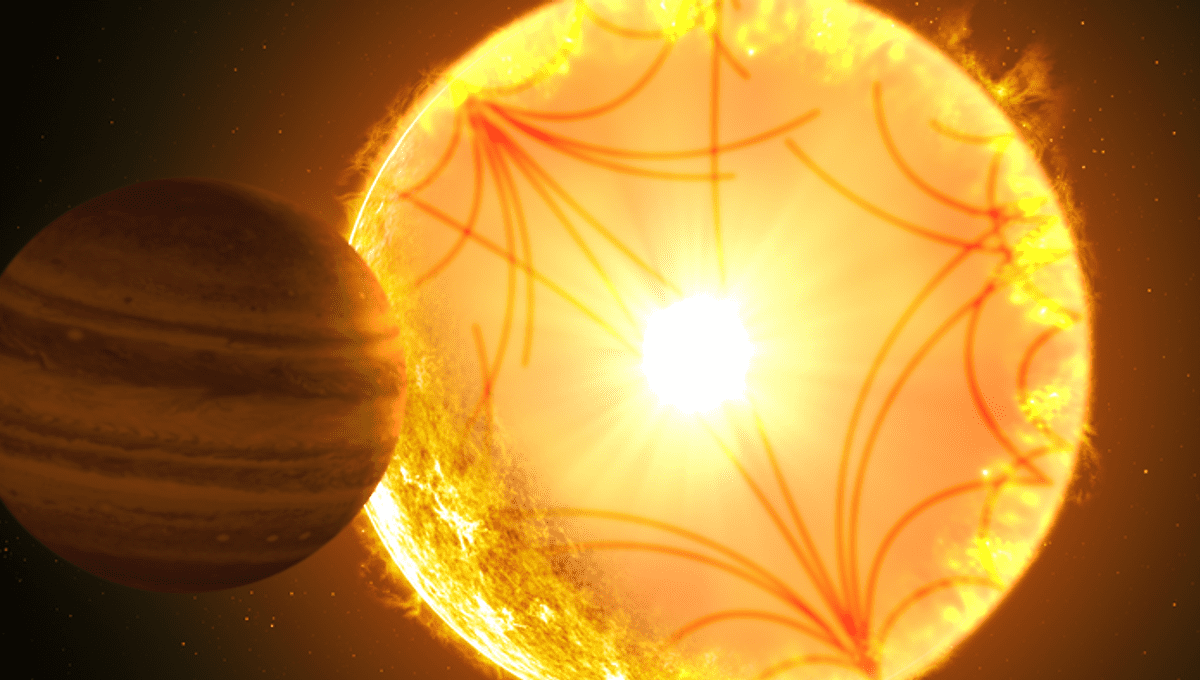
The planet Kepler-1658B is not long for this, or any other, world. It’s on a death spiral to be assimilated, Borg-like into the star Kepler-1658. The doomed (very) hot Jupiter will give astronomers their first opportunity to measure an important part of star systems’ development.
As stars age and run out of hydrogen to fuse in their core they enter a red giant phase where their temperature falls, but their volume expands. In the process they absorb their inner planets, something that will happen to Mercury and Venus one day, and possibly also to Earth.
Astronomers have detected the increased concentration of heavy elements in the atmospheres of stars that have eaten their planets, but they’ve never seen a planet get engulfed. Planets have also been observed with decaying orbits putting them on a death march to their star, but these were under different circumstances, not those that will eventually face our own inner planets. A paper in the Astrophysical Journal Letters on Kepler-1658b changes that.
“We’ve previously detected evidence for exoplanets inspiraling toward their stars, but we have never before seen such a planet around an evolved star,” said Dr Shreyas Vissapragada of the Harvard and Smithsonian in a statement. “Theory predicts that evolved stars are very effective at sapping energy from their planets’ orbits, and now we can test those theories with observations.”
Rather than suffering drag from the star’s atmosphere’s outer layers, like a piece of space junk in low Earth orbit, Kepler-1658b’s problem is tidal. The gravitational pull of the planet and its star raises a bulge on each, releasing energy in the process. The loss of energy causes orbital decay, bringing the planet closer to the star and therefore increasing the strength of the tides, accelerating an initially slow process.
Ironically, in the Earth-Moon system tidal reactions are pushing the two bodies apart. This can happen with planets and stars as well – the direction of the effect depends on the distances between objects and their rotation rates, but Kepler-1658b drew the short straw.
“Now that we have evidence of inspiraling of a planet around an evolved star, we can really start to refine our models of tidal physics,” Vissapragada said.
Tidal interactions with a larger body can generate internal heat. This is what has made the moon Io so extraordinarily volcanic, and provided the warmth to keep the oceans within Europa and Enceladus liquid. The same may be true for Kepler-1658b, which would explain why it is even hotter than its orbital distance would suggest.
Among the thousands of planets discovered orbiting other stars are some that may be in the early part of the process, but the decay is currently small enough we can’t measure it precisely enough to be certain.
Kepler-1658b, on the other hand, has an orbit that is decreasing by 0.131 seconds per year, an astonishingly tiny amount to be able to measure with confidence. Only by comparing the timing of Kepler’s initial observations of the system 13 years ago and more recent measurements made by the Hale Telescope – once the largest in the world – and Kepler’s successor TESS could Vissapragada and co-authors prove their case.
Kepler-1658 is only in a subgiant phase, not yet a true giant, but with a mass 45 percent greater than the Sun, its brightness is intense. Meanwhile, the planet orbits at 0.05 AU, one-eighth of the distance from its star as Mercury is from the Sun, taking just 3.8 days to do it.
Coincidently, Kepler-1658b was the first candidate for an exoplanet the planet-finding telescope found. However, misestimates of the planet star’s size delayed confirmation, and planets were confirmed around 1,657 other stars before its existence was validated.
The paper is published in The Astrophysical Journal Letters
Source Link: Doomed Planet Found In A Death Spiral Around A Bloating Star